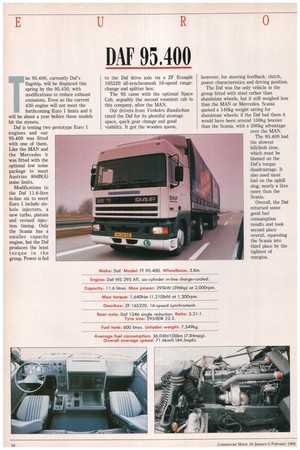DAF 95.400
Page 36

If you've noticed an error in this article please click here to report it so we can fix it.
he 95.400, currently Daf's flagship, will be displaced this spring by the 95.430, with modifications to reduce exhaust emissions. Even so the current 430 engine will not meet the forthcoming Euro 1 limits and it will be about a year before these models hit the streets.
Daf is testing two prototype Euro 1 engines and our 95.400 was fitted with one of them. Like the MAN and the Mercedes it was fitted with the optional low noise package to meet Austrian 80dB(A) noise limits.
Modifications to the Daf 11.6-litre in-line six to meet Euro 1 include sixhole injectors, a new turbo, pistons and revised injection timing. Only the Scania has a smaller capacity engine, but the Daf produces the least torque in the group. Power is fed to the Daf drive axle via a ZF Ecosplit 16S220 all-synchromesh 16-speed rangechange and splitter box.
The 95 came with the optional Space Cab, arguably the second roomiest cab in this company, after the MAN.
Our drivers from Verkehrs Rundschau rated the Daf for its plentiful stowage space, quick gear change and good visibility. It got the wooden spoon, however, for steering feedback, clutch, power characteristics and driving position.
The Daf was the only vehicle in the group fitted with steel rather than aluminium wheels, but it still weighed less than the MAN or Mercedes. Scania quoted a 140kg weight saving for aluminium wheels: if the Daf had them it would have been around 100kg heavier than the Scania, with a 200kg advantage over the MAN.
The 95.400 had the slowest hillclimb time, which must be blamed on the Daf's torque disadvantage. It also used most fuel on the uphill slog; nearly a litre more than the Scania.
Overall, the Daf returned some good fuel consumption results and took second place overall, squeezing the Scania into third place by the tightest of margins.
















































































